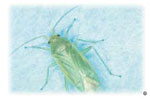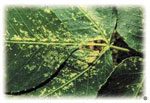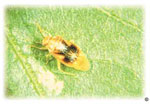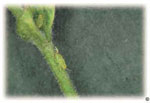The damage ash plant bugs cause to ash trees becomes evident in late May and June when leaves develop a whitish or yellowish mottling on the upper leaf surface. Insects are usually found on the underside of the leaf where they feed on plant sap and leave small black dots or droppings.
Ash plant bug adults are pale yellow and brown to almost black in color and are three eighths of an inch long. They have an elongated oval shape and a triangular pattern on the back where the wings fold. They’re typical of other “true bugs” like the box elder bug, squash bug and stink bug. Their young are similar in appearance, minus the wings.
This common pest can be found on leaves throughout the growing season, first appearing in early May as leaves start to unfold. The whitish mottling develops as the bugs feed on plant sap, which damages leaf tissues. Feeding damage on newly unfolding leaves may appear as brown or burned areas, and severe infestations may cause premature leaf drop. Damage is most severe from early-season feeding, when leaf tissues are young and tender.
 Damage from ash plant bugs is mostly cosmetic. Healthy trees are not severely hurt by their feeding, and control is unnecessary. Trees at high risk include new transplants and trees under stress, such as those suffering from drought.
Damage from ash plant bugs is mostly cosmetic. Healthy trees are not severely hurt by their feeding, and control is unnecessary. Trees at high risk include new transplants and trees under stress, such as those suffering from drought.
Insecticides help protect the appearance of infested trees only if they are applied in early May when insects first appear. This usually occurs sevento ten days after leaf-buds open. Insecticides applied after symptoms become highly noticeable have little value.
Insecticides applied after symptoms become highly noticeable have little value.
Insecticides registered for use include Orthene (acephate), insecticidal soaps, permethrin, bifenthrin, and cyfluthrin. Be sure to read and follow label directions when using any insecticide.



